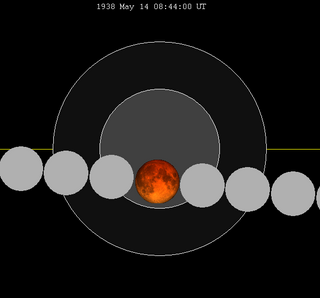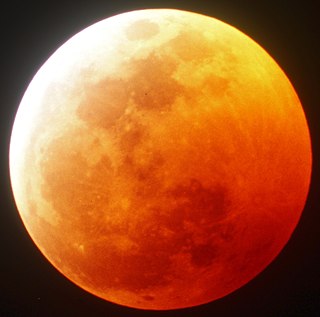
A total lunar eclipse took place on Saturday, May 14, 1938. This was the last total lunar eclipse of Saros cycle 120. It was visible from Oceania, the Pacific Ocean, North America, South America and Antarctica.

A total lunar eclipse took place on Saturday, May 14, 1938. This was the last total lunar eclipse of Saros cycle 120. It was visible from Oceania, the Pacific Ocean, North America, South America and Antarctica.
| Ascending node | Descending node | |||||
|---|---|---|---|---|---|---|
| Saros | Date Viewing | Type Chart | Saros | Date Viewing | Type Chart | |
| 110 | 1937 May 25  | Penumbral | 115 | 1937 Nov 18  | Partial | |
| 120 | 1938 May 14  | Total | 125 | 1938 Nov 07  | Total | |
| 130 | 1939 May 03  | Total | 135 | 1939 Oct 28  | Partial | |
| 140 | 1940 Apr 22  | Penumbral | 145 | 1940 Oct 16  | Penumbral | |
A lunar eclipse will be preceded and followed by solar eclipses by 9 years and 5.5 days (a half saros). [1] This lunar eclipse is related to two total solar eclipses of Solar Saros 127.
| May 9, 1929 | May 20, 1947 |
|---|---|
 |  |

A total lunar eclipse took place on May 4, 2004, the first of two total lunar eclipses in 2004, the second being on October 28, 2004.

A total lunar eclipse took place on October 27–28, 2004, the second of two total lunar eclipses in 2004, the first being on May 4, 2004. It was the first lunar eclipse to take place during a World Series game, which when seen from Busch Memorial Stadium in St, Louis, Missouri, provided a surreal sight on the night the Boston Red Sox won their first World Series in 86 years to end the Curse of the Bambino. Occurring 5.6 days before apogee, the Moon's apparent diameter was smaller. The moon was 10.1 days after perigee and 5.6 days before apogee.

A penumbral lunar eclipse took place on 14 March 2006, the first of two lunar eclipses in 2006.

A partial lunar eclipse occurred on 26 June 2010, the first of two lunar eclipses in 2010. At maximum eclipse, 53.68% of the Moon was covered by the Earth's shadow.

A total lunar eclipse took place on Tuesday 9 January 2001, the first of three lunar eclipses in 2001. A shallow total eclipse saw the Moon in relative darkness for 1 hour 1 minute and 2 seconds. The Moon was 18.89% of its diameter into the Earth's umbral shadow, and totality was observed in all of Europe, Africa, and Asia. The partial eclipse lasted for 3 hours 16 minutes and 19 seconds and was visible in parts of north-eastern North America and Australia. It is the only total eclipse of 2001. It was visible over Asia and Western Australia with the Middle East getting mid eclipse at midnight.

A total lunar eclipse took place on Monday, November 29, 1993, the second of two total lunar eclipses in 1993, the first was on Friday, June 4.

A total lunar eclipse will take place on August 7, 2036. The southern tip of the moon will pass through the center of the Earth's shadow. This is the last central lunar eclipse of Saros cycle 129.

A total lunar eclipse took place on Friday, June 4, 1993, the first of two total lunar eclipses in 1993, the second being on Monday, November 29. The Moon was plunged into darkness for 1 hour and 36 minutes, in a deep total eclipse which saw the Moon 56% of its diameter inside the Earth's umbral shadow. The visual effect of this depends on the state of the Earth's atmosphere, but the Moon may have been stained a deep red colour. The partial eclipse lasted for 3 hours and 38 minutes in total. The moon passed through the center of the Earth's shadow.

A total lunar eclipse will take place on July 7, 2047. It will last 1 hour 40 minutes and 49 seconds and will plunge the full Moon into deep darkness, as it passes right through the centre of the Earth's umbral shadow. While the visual effect of a total eclipse is variable, the Moon may be stained a deep orange or red colour at maximum eclipse. This will be a great spectacle for everyone who sees it. The partial eclipse will last for 3 hours and 39 minutes in total.
A total lunar eclipse took place on Saturday, May 24 and Sunday, May 25, 1975, the first of two total lunar eclipses in 1975. The Moon was plunged into darkness for 1 hour and 28 minutes in a deep total eclipse which saw the Moon 43% of its diameter inside the Earth's umbral shadow. The visual effect of an eclipse depends on the state of the Earth's atmosphere, but the Moon may have been stained a deep red colour. The partial eclipse lasted for 3 hours and 35 minutes in total. Occurring only 4.4 days after perigee, the Moon's apparent diameter was 0.7% larger than average. The moon was 377,010 km from the Earth at greatest eclipse.

A total lunar eclipse took place on Thursday, June 25, 1964. The moon passed through the center of the Earth's shadow.
A total lunar eclipse took place on Monday, October 28, 1985, the second of two total lunar eclipses in 1985, the first being on May 4, 1985.
A penumbral lunar eclipse took place on Tuesday, April 14, 1987, the first of two lunar eclipses in 1987, the second being on October 7, 1987. This subtle penumbral eclipse may have been visible to a skilled observer at maximum eclipse. 77.703% of the Moon's disc was partially shaded by the Earth, which caused a gentle shadow gradient across its disc at maximum; the eclipse as a whole lasted 3 hours, 54 minutes and 12.8 seconds. The Moon was just 4.6 days before perigee, making it 0.5% larger than average.

A partial lunar eclipse occurred on 19 November 2021. The eclipse occurred towards a micromoon. This was the longest partial lunar eclipse since 18 February 1440, and the longest until 8 February, 2669; however, many eclipses, including the November 2022 lunar eclipse, have a longer period of umbral contact at next to 3 hours 40 minutes. It was often referred to as a "Beaver Blood Moon" although not technically fulfilling the criteria for a true blood moon (totality).
A penumbral lunar eclipse will take place on Monday, March 25, 2024. It will be visible to the naked eye as 95.57% of the Moon will be immersed in Earth's penumbral shadow.
A total lunar eclipse took place on Saturday, September 16, 1978, the second of two total lunar eclipses in 1978. The Moon was plunged into darkness for 1 hour, 18 minutes and 39 seconds, in a deep total eclipse which saw the Moon 32.683% of its diameter inside the Earth's umbral shadow. The visual effect of this depends on the state of the Earth's atmosphere, but the Moon may have been stained a deep red colour. The partial eclipse lasted for 3 hours, 27 minutes and 11.6 seconds in total.

A total lunar eclipse took place on Monday, May 13, 1957, the third of fourteen total lunar eclipses of Lunar Saros 130. The Moon was plunged into darkness for 1 hour and 18 minutes, in a deep total eclipse which saw the Moon 30% of its diameter inside the Earth's umbral shadow. The visual effect of this depends on the state of the Earth's atmosphere, but the Moon may have been stained a deep red colour. The partial eclipse lasted for 3 hours and 32 minutes in total.

A total lunar eclipse will take place on July 29, 2083. The Moon will be plunged into darkness for 1 hour and 30 minutes, in a deep total eclipse which will see the Moon 48.3% of its diameter inside the Earth's umbral shadow. The visual effect of this depends on the state of the Earth's atmosphere, but the Moon may be stained a deep red colour. The partial eclipse will last for 3 hours and 33 minutes in total.

A total lunar eclipse will take place on July 17, 2065. A dramatic total eclipse lasting 1 hour and 37 minutes will plunge the full Moon into deep darkness, as it passes right through the centre of the Earth's umbral shadow. While the visual effect of a total eclipse is variable, the Moon may be stained a deep orange or red colour at maximum eclipse. This will be a great spectacle for everyone who sees it. The partial eclipse will last for 3 hours and 36 minutes in total. The moon will pass through the center of the Earth's shadow.

A total lunar eclipse took place on Monday, May 3, 1920. It was visible from North America, South America, Europe, Africa, Middle east and Antarctica.